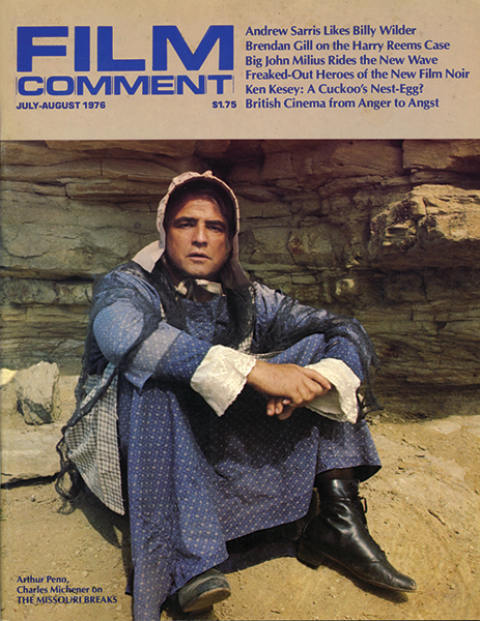
Independents: A Reader’s Digest of the Avant-Garde
An event of rather large symptomatic significance occurred in New York in May 1976: the most ambitious, most official, most elaborate attempt ever to rewrite the history of the American film avant-garde to fit it into the Procrustean bed of Formal/Structural Cinema. Sponsored and blessed by such august institutions as the Whitney Museum, the American Federation of Art, the Museum of Modern Art, and the National Endowment for the Arts, it consists, in all its shame and glory, of seven ninety-minute programs purporting to tell the story of the American avant-garde. It was selected by the Whitney's present Film Curator, approved by Willard Van Dyke's Film Committee of the American Federation of Arts, and is distributed by the AFA nationally. It comes accompanied by an elaborate book of essays entirely written by doctoral candidates at the Department of Cinema Studies of New York University, the academic fountainhead of Formal Cinema in America, which also supplies the obligatory(!) speaker to travel with the series.

At first glance, it’s a seemingly admirable venture, bespeaking a seriousness of purpose appropriate to the otherwise often maligned avant-garde, relating it to modern art and treating it as the national resource and achievement it is. For those innocent of the past, this becomes the official history of the movement, given the imprimatur and sheer weight of the sponsoring organizations.
The responsibility for this “history” will rest heavily on their shoulders. For what emerges on closer inspection is not the evolution of a movement, based on facts, but the imposition of a sectarian thesis, based on omission and distortion.
To one who has himself been part of the movement and for almost two decades was the first to publicly exhibit (at Cinema 16) almost all of its major talents (while marveling at its vibrant messiness, its beautiful and wild diversity, its geniuses, neurotics, epigones, united only by their opposition to commercial cinema), the current exhibition represents a desperate attempt at classification and synthesis by surgery, excommunication, and erasure of individuals, institutions, filmmakers, critics, foundations, award systems, and publications. This is not history, but the silence of a denominational graveyard that keeps out inferior creeds. Here everything is clear; all is complete. The keepers of the graveyard pour over their orderly ledgers in satisfaction; but the reality and truth of the movement, its loves and passions, its diversities and ambiguities rest only a few feet beneath the tranquil surface.
To try to tell the real history of that movement means, first of all, to exhibit all of its major talents and tendencies, its contradictions and its eclecticism; it is possible only by the most scrupulous adherence to facts and the most rigorous testing of hypotheses if one subsequently wants to determine the deeper structural patterns underlying its development. The truncating of a movement, however, the full-scale elimination of large numbers of important directors, the enforced revelation of non-existing patterns based on preconceived ideas is not history but metaphysics. To set up a straight line or even ideological affinity between Maya Deren (whose mythological, lyrical, Freudian work opens the series) and Hollis Frampton (whose formal-structural work ends it in triumphant culmination); to transform Peterson, Broughton, and Deren into mere building blocks inexorably squeezed into an ultimate edifice of Formal Cinema; to pretend, in fact, that the entire American film avant-garde since its inception had been teleologically tending toward just such a Formal Cinema conclusion, are acts of supreme, desperate, ludicrous audacity better characterized as “nerve.” This post-facto attempt to prove the immanence of Formal Cinema in the American avant-garde from its very inception represents a false and temporary victory of the papal and talmudic spirit over recalcitrant reality.
Only those who do not know me or my writings could conclude from the above that I am opposed to Formal Cinema, writing about it “from the outside,” as did the antediluvian Andrew Sarris in his recent Village Voice attack on this same event. The fact is that I consider several of the formal films in this exhibition (and even others not included) crucial to the American avant-garde, have shown them publicly and in classrooms, and view several leaders of this tendency among the important avant-gardists of the day.
I refuse, however, to equate this one tendency with the avant-garde as such. I refuse to read out of the movement the large number of major talents, who do not “fit” somebody’s metaphysical notion of what the avant-garde is. I refuse, in short, a “history” that omits exactly as many major talents as it includes, that omits the pivotal role of such pioneers as Maya Deren, the Creative Film Foundation, the Creative Film Foundation sixteen year activities of America’s largest film society, Cinema 16.
These fundamental omissions and falsifications will be documented in two subsequent columns, as will be the strategies employed and the ideological intent, of this ill-conceived Reader’s Digest distortion.
A particularly noxious example is the manner in which the pioneering role of the late David Bienstock, first curator at the Whitney and founder of its New Filmmakers Series, is treated by these revisionists. For without this courageous man-who represented the very opposite of the values espoused by the current exhibition-neither the film program at the Whitney nor, ironically, the present series could have occurred. It is profoundly tragic that his achievement and heritage, in death, have been transmuted into their opposite. For those who know his role and that of others equally erased, to set the record straight is an act of moral necessity.







